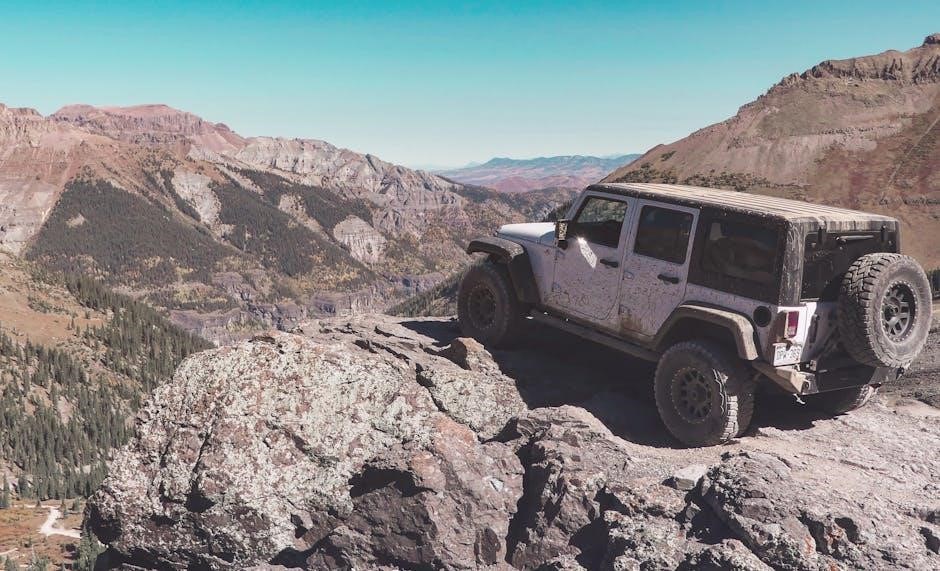Welcome to the 2015 Jeep Wrangler Owner’s Manual, your comprehensive guide to understanding and maintaining your vehicle․ This manual provides essential information on features, safety, and proper usage to ensure optimal performance and longevity of your Jeep Wrangler․
Overview of the 2015 Jeep Wrangler
The 2015 Jeep Wrangler is a iconic off-road vehicle known for its rugged design and versatility․ It continues the legacy of the classic Jeep, offering unmatched 4WD capabilities and a durable build․ Available in two-door and four-door configurations (Wrangler and Wrangler Unlimited), it appeals to adventure seekers and practical users alike․ The 2015 model features a 3․6L V6 engine, delivering 285 horsepower and 260 lb-ft of torque, paired with a six-speed manual or five-speed automatic transmission․ Its removable roof and foldable windshield maintain the Wrangler’s traditional charm․ The interior includes basic yet functional controls, with optional upgrades like a touchscreen infotainment system․ This year’s model also saw minor updates in styling and technology, ensuring it remains a top choice for off-road enthusiasts and everyday drivers seeking a dependable SUV․
Importance of Reading the Owner’s Manual
Reading the 2015 Jeep Wrangler Owner’s Manual is crucial for understanding your vehicle’s operation, safety features, and maintenance requirements․ It provides detailed information on proper driving techniques, especially for off-road use, ensuring you maximize performance and safety․ The manual also explains the 4WD system, including when and how to engage it, which is essential for handling various terrains․ Additionally, it covers essential maintenance schedules, fluid levels, and troubleshooting tips to prevent costly repairs․ By familiarizing yourself with the manual, you can optimize fuel efficiency, understand warning lights, and utilize advanced features like the Uconnect infotainment system․ Ignoring the manual may lead to misuse of the vehicle, potentially causing damage or safety hazards․ It’s a vital resource for both new and experienced owners, helping you get the most out of your Jeep Wrangler while ensuring longevity and reliability․
Symbols and Conventions Used in the Manual
The 2015 Jeep Wrangler Owner’s Manual uses specific symbols and conventions to convey important information clearly and efficiently․ These symbols are designed to help you quickly identify key features, warnings, and maintenance requirements․ Common symbols include warning signs for potential hazards, such as high temperatures or low oil levels, and informational icons for features like cruise control or four-wheel drive․ The manual also employs color coding, with yellow indicating cautions and red highlighting critical safety information․ Additionally, abbreviations and acronyms are defined within the text to ensure clarity․ Understanding these symbols and conventions is essential for interpreting the manual correctly and ensuring the safe, effective operation of your vehicle․ By familiarizing yourself with these visual cues, you can navigate the manual with confidence and address any issues promptly․

Key Features of the 2015 Jeep Wrangler
The 2015 Jeep Wrangler boasts a rugged exterior design, removable tops, and advanced off-road capabilities․ It features a reliable 4WD system, durable interior controls, and modern technological upgrades for enhanced performance․
Exterior Design and Components
The 2015 Jeep Wrangler features a classic, rugged exterior design with a focus on durability and off-road capability․ Its removable tops, fold-down windshield, and lightweight yet robust frame are hallmarks of the Wrangler’s iconic style․ The exterior components include a high-strength steel frame, skid plates for underbody protection, and a choice of hardtop or soft top options․ The Wrangler’s design emphasizes practicality, with easy-to-clean surfaces and a minimalist aesthetic that withstands harsh environments․ The front grille, round headlights, and flat fenders maintain the Wrangler’s timeless look․ Exterior components are designed to endure rough terrain, ensuring reliability and performance in various conditions․
Interior Features and Controls
The 2015 Jeep Wrangler’s interior is designed for functionality and comfort, blending ruggedness with modern amenities․ The dashboard features intuitive controls for heating, ventilation, and air conditioning, while the instrument cluster provides clear visibility of vital vehicle information․ Seats are durable and supportive, with optional upgrades like heated seats for enhanced comfort․ The center console houses essential controls, including the gearshift and transfer case controls for four-wheel-drive operation․ Storage compartments are strategically placed for convenience, including a glove box and cup holders․ The optional Uconnect infotainment system offers touchscreen navigation, Bluetooth connectivity, and USB ports, catering to both entertainment and connectivity needs․ The interior design prioritizes ease of use, ensuring drivers can focus on the road ahead, whether navigating urban streets or off-road trails․
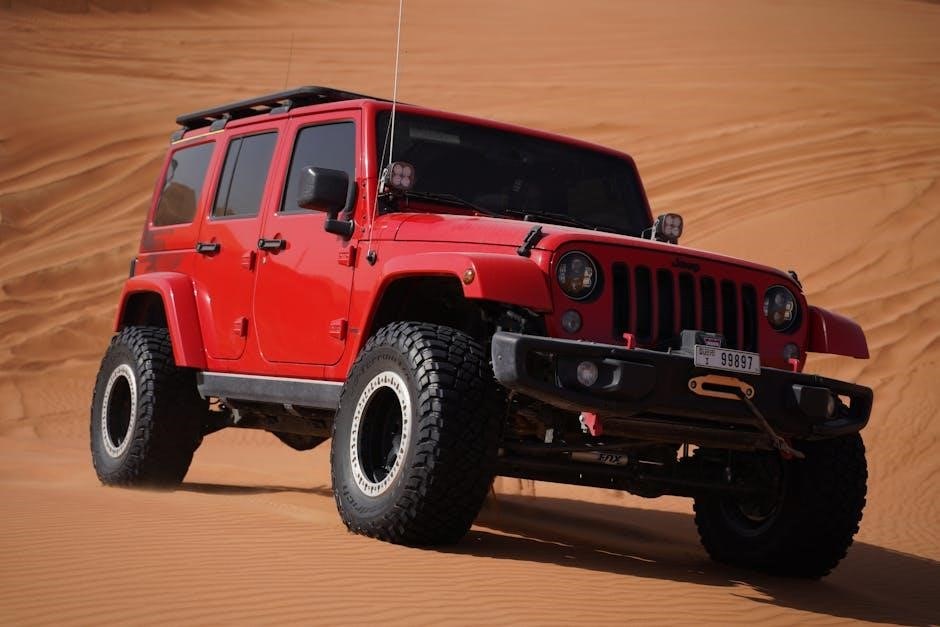
Technological Advancements in the 2015 Model
The 2015 Jeep Wrangler introduces several technological advancements to enhance both on-road and off-road experiences․ The Uconnect infotainment system now features a higher-resolution touchscreen with improved responsiveness and navigation capabilities․ Bluetooth connectivity has been optimized for seamless pairing with smartphones, and voice command functionality allows for hands-free control of phone calls and music playback․ Additionally, the 2015 model incorporates electronic stability control as a standard feature, providing greater stability and traction on various terrains․ The optional Alpine premium audio system delivers superior sound quality, with a 552-watt, 10-speaker setup for an immersive listening experience․ These advancements ensure the Wrangler remains modern and connected while maintaining its rugged, adventure-ready DNA․
Off-Road Capabilities and 4WD System
The 2015 Jeep Wrangler is renowned for its exceptional off-road capabilities, supported by its robust 4WD system․ The Wrangler features a part-time four-wheel-drive system, which includes high and low range modes for different terrains․ In low range, the vehicle gains maximum torque for crawling over rocks or steep inclines, while high range maintains speed on flat trails․ The system automatically switches between two-wheel and four-wheel drive, enhancing traction on uneven surfaces․ The Wrangler’s high ground clearance and approach/departure angles allow it to navigate steep inclines without undercarriage damage․ Skid plates protect vital components when driving over rocks or logs․ The vehicle also boasts a water fording capability, enabling it to traverse shallow water safely․ Hill descent control helps maintain a controlled speed during steep descents, and the transfer case efficiently distributes power between axles․ These features make the Wrangler a top choice for off-road enthusiasts, combining durability and versatility for the toughest terrains․
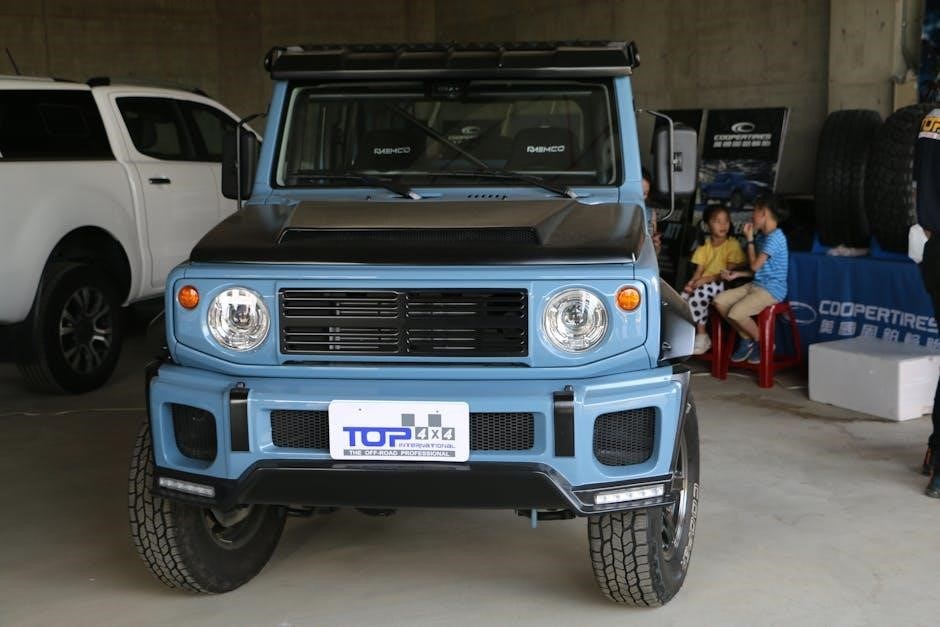
Maintenance and Care
Regular maintenance preserves your Jeep Wrangler’s performance and longevity․ Adhere to the recommended schedule for oil changes, tire rotations, and inspections to ensure optimal durability and reliability always․
Routine Maintenance Schedule
The 2015 Jeep Wrangler requires regular maintenance to ensure peak performance and longevity․ The recommended schedule includes oil changes every 5,000 to 7,500 miles, depending on driving conditions․ Tire rotations should be performed every 6,000 to 8,000 miles to maintain even tread wear․ Inspections of belts, hoses, and fluids are advised every 15,000 to 30,000 miles․ Brake pads and rotors should be checked annually or when symptoms like squeaking occur․ The air filter should be replaced every 15,000 miles or as needed based on driving conditions․ Battery terminals should be cleaned and tested every 6 months․ Adhering to this schedule helps prevent breakdowns and ensures your Jeep remains reliable for both on-road and off-road adventures․ Always consult the owner’s manual for specific recommendations and keep a maintenance log to track services performed․
Fluids and Lubricants Recommended
The 2015 Jeep Wrangler requires specific fluids and lubricants to maintain optimal performance and durability․ The recommended engine oil is 5W-20 synthetic blend, which provides excellent protection in varying temperatures․ The coolant should be a 50/50 mix of ethylene glycol and distilled water to prevent overheating and corrosion․ Transmission fluid should be ATF+4 for smooth gear shifts and system longevity․ Brake fluid must meet DOT 3 specifications to ensure reliable stopping power․ For the differential, use genuine Jeep gear oil with the correct viscosity for your axle type․ Always check fluid levels regularly and top up as needed, using the specified types to avoid damage․ Refer to the owner’s manual for exact capacities and specifications․ Using the wrong fluids can void warranties or lead to premature wear, so adherence is crucial for maintaining your Wrangler’s health․
Tire Pressure and Rotation Guidelines
Proper tire pressure and rotation are essential for the 2015 Jeep Wrangler’s performance, safety, and fuel efficiency․ The recommended tire pressure is listed on the Tire and Loading Information placard on the driver’s side doorjamb․ Check pressure monthly, before long trips, and when tires are cold․ Under-inflation can lead to uneven wear, reduced traction, and increased risk of tire failure․ Rotate tires every 8,000 to 12,000 miles following the pattern outlined in the manual to ensure even tread wear․ For off-road driving, consider more frequent rotations to account for additional stress․ Always use a spare tire of the correct size and pressure․ Improper tire pressure or rotation can void warranties and compromise handling, especially in 4WD mode․ Adhere to these guidelines to maximize tire life, enhance safety, and maintain optimal vehicle performance․
Battery Maintenance Tips
Proper maintenance of your 2015 Jeep Wrangler’s battery ensures reliable starting power and prevents premature wear․ Always wear protective gloves and eyewear when handling the battery․ Check the terminals regularly for corrosion and clean them with a wire brush if necessary․ Ensure the battery is securely fastened to prevent movement, which can cause internal damage․ Avoid overcharging, as it can reduce battery life․ Test the battery voltage periodically using a multimeter; a fully charged battery should read around 12․6 volts․ Inspect the battery case for cracks or leaks and replace it immediately if damage is found․ If the vehicle will be unused for an extended period, disconnect the negative battery cable to prevent drain; For extreme temperatures, consider using a battery maintainer to keep the charge level stable․ Follow these tips to extend the lifespan of your Wrangler’s battery and ensure consistent performance․
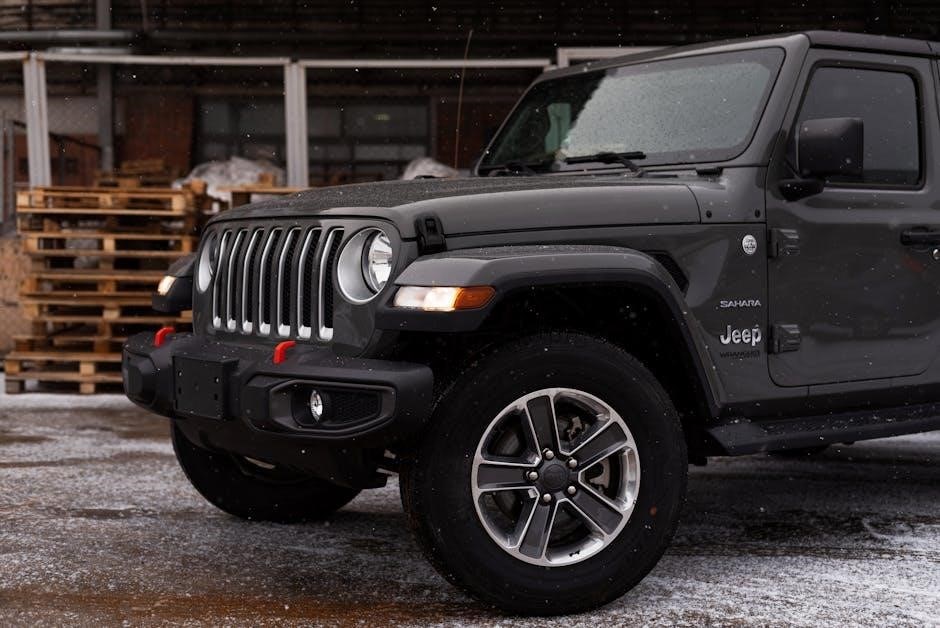
Driving Tips and Best Practices
Safe driving practices, optimizing fuel efficiency, and off-road techniques are essential for a smooth and enjoyable experience in your 2015 Jeep Wrangler․ Always prioritize safety and vehicle control․
Safe Driving Practices for the Jeep Wrangler
To ensure a safe driving experience in your 2015 Jeep Wrangler, always wear a seatbelt and ensure all passengers do the same․ Avoid excessive speed, especially on uneven terrain or in adverse weather conditions․ Maintain a safe distance from other vehicles and be aware of your surroundings․ Keep your eyes on the road and avoid distractions like using electronic devices while driving․ Familiarize yourself with the vehicle’s dimensions to navigate tight spaces safely․ Never overload the vehicle beyond its recommended capacity, as this can affect handling and stability․ Use brakes gently but firmly, especially when descending steep inclines or driving off-road․ Always follow traffic laws and regulations, and be cautious of pedestrian and wildlife activity․ Regularly check mirrors and blind spots for better visibility․ For more detailed guidance, refer to the owner’s manual․
Optimizing Fuel Efficiency
Optimizing fuel efficiency in your 2015 Jeep Wrangler is crucial for maximizing its performance and reducing operating costs․ Maintain consistent driving speeds, as sudden acceleration and braking can lower fuel economy․ Regularly check and maintain proper tire pressure, as under-inflated tires can decrease efficiency․ Avoid idling for extended periods, as this wastes fuel․ Use the Wrangler’s 4WD system only when necessary, as it consumes more fuel․ Keep the vehicle’s air filter clean, as a dirty filter can reduce fuel efficiency․ Remove unnecessary weight from the vehicle, as extra load can decrease mileage․ Use cruise control on highways to maintain a steady speed․ Finally, monitor your driving habits and adjust them to prioritize fuel-saving practices․ For more tips, refer to the owner’s manual․
Off-Road Driving Techniques
Mastering off-road driving techniques is essential to get the most out of your 2015 Jeep Wrangler․ Always choose the appropriate 4WD mode for the terrain—4H for high-speed trails and 4L for low-speed, high-torque situations․ Maintain control by keeping your speed steady and avoiding sudden acceleration or braking․ Use the transfer case wisely, ensuring it’s in the correct mode for the terrain․ When navigating steep inclines, maintain momentum but avoid wheel spin․ On descents, downshift or use hill descent control (if equipped) to control speed․ Avoid crossing water deeper than the manual recommends, and always test the depth first․ Use low gear for steep climbs and high gear for flat terrain․ Keep your eyes on the path ahead, and avoid sudden steering movements․ Brake gently and avoid skidding․ For detailed instructions, consult the owner’s manual and practice in a controlled environment․

Customization and Modifications
The 2015 Jeep Wrangler offers endless customization options, including aftermarket accessories, lift kits, and performance upgrades․ Owners can enhance both aesthetics and functionality to suit their preferences and needs․
Popular Aftermarket Accessories
Popular aftermarket accessories for the 2015 Jeep Wrangler include lift kits, off-road wheels, and protective bumpers․ LED light bars and roof racks are also favored for enhanced utility․ Many owners opt for performance upgrades like cold-air intakes and exhaust systems to boost power; Interior upgrades, such as premium seat covers and dash trim kits, add comfort and style․ Suspension modifications, like coilovers, improve handling both on- and off-road․ Winches and recovery gear are essential for serious off-road enthusiasts, while fender flares and side steps enhance durability and accessibility․ These accessories allow owners to tailor their Wrangler to their lifestyle, whether for daily driving or extreme adventures․ Always ensure compatibility and proper installation to maintain safety and warranty coverage․
DIY Modifications for Enhanced Performance
Several DIY modifications can enhance the performance of your 2015 Jeep Wrangler․ Upgrading the air filter to a high-flow unit can improve airflow, potentially increasing horsepower and fuel efficiency․ Adjusting the suspension, such as installing coil spacers or tweaking torsion bars, can enhance handling and ground clearance․ Modifying the exhaust system, like adding a cat-back exhaust, can reduce back pressure and improve engine performance․ Enhancing throttle response with a recalibrated throttle controller can provide better control, especially during off-road adventures․ Additionally, engine tuning or reflashing the ECU can optimize performance for specific driving conditions․ All modifications should be compatible with your vehicle and comply with local regulations․ Always ensure safety and proper installation to maintain your Wrangler’s reliability and performance․

Troubleshooting and Diagnostics
This section helps identify and resolve common issues with your 2015 Jeep Wrangler․ Learn to recognize symptoms, use diagnostic tools, and interpret error codes effectively․
Common Issues and Solutions
The 2015 Jeep Wrangler may experience certain issues that owners can address with proper knowledge․ Common problems include a hard-to-start engine, often due to worn spark plugs or a failing starter motor․ Rough idling or stalling may indicate faulty oxygen sensors or a clogged air filter․ Transmission slipping or hesitation can result from low fluid levels or worn clutch packs․ The 4WD system may malfunction if the vacuum hoses or electrical connections are damaged․ Additionally, some owners report issues with the infotainment system freezing, which can be resolved by resetting the system or updating the software․ For each problem, the manual provides step-by-step solutions, such as checking fluid levels, replacing filters, or inspecting electrical connections․ Regular maintenance, as outlined in the manual, can prevent many of these issues from arising․ Always consult the manual before attempting repairs․
Using Diagnostic Tools and Codes
The 2015 Jeep Wrangler is equipped with an onboard diagnostics (OBD-II) system, which helps identify issues through specific codes․ Owners can use a code reader or scan tool to retrieve these codes from the vehicle’s computer․ The diagnostic port is located under the dashboard on the driver’s side․ Common codes include P0171 for system too lean, P0300 for random cylinder misfire, or P0455 for evaporative system leaks․ The manual provides a list of codes and their meanings, allowing owners to understand the problem․ Once identified, repairs can be made, and the codes can be cleared using the scan tool․ Regular use of diagnostic tools helps maintain the vehicle’s health and prevents minor issues from becoming major problems․ Always refer to the manual for code interpretations and troubleshooting steps;
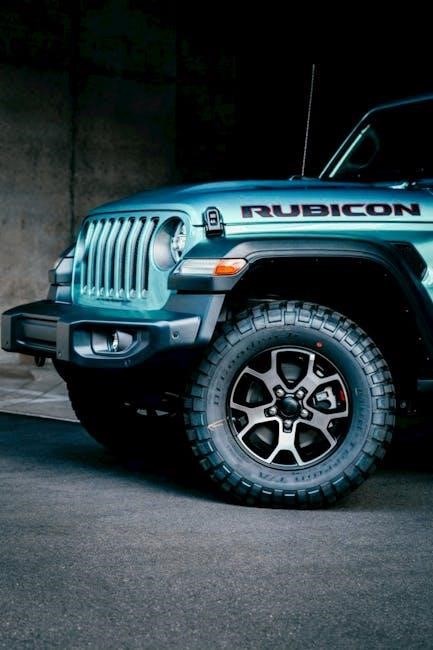
Safety Features and Emergency Procedures
The 2015 Jeep Wrangler includes advanced safety features like multiple airbags, electronic stability control, and a robust frame for rollover protection․ Emergency procedures include securing the vehicle and following recovery guidelines․
Built-In Safety Features
The 2015 Jeep Wrangler is equipped with a range of built-in safety features designed to protect occupants and prevent accidents․ These include dual front airbags, optional front side airbags, and a sturdy frame to enhance rollover protection․ The electronic stability control system helps maintain vehicle stability, while the anti-lock braking system (ABS) improves stopping power on various surfaces․ Additionally, the Wrangler features a high-strength steel frame and a robust body structure to absorb and distribute crash energy effectively․ The vehicle also includes features like traction control to prevent wheel slippage and hill start assist to maintain control during inclines․ These safety features work together to provide a secure driving experience, both on-road and off-road․ The Wrangler’s design prioritizes occupant safety, making it a reliable choice for adventurers and daily drivers alike․
Emergency Procedures and Precautions
In the event of an emergency, the 2015 Jeep Wrangler is equipped with features and procedures to ensure safety․ If the vehicle must be towed, use only the designated towing points to avoid damage․ For jump-starting, follow the manual’s guidelines to connect batteries safely and avoid electrical system damage․ In case of a breakdown, activate hazard lights and remain in the vehicle with seatbelts fastened․ For a flat tire, use the spare tire and tools provided, ensuring the vehicle is on level ground and in park․ If a fire occurs, evacuate the vehicle immediately and use a fire extinguisher rated for automotive fires; Always keep an emergency kit with items like a flashlight, first aid kit, and reflective triangles․ Follow proper procedures for winching and recovery in off-road situations to prevent accidents․ These precautions help ensure safety in unexpected situations․ Regularly check emergency equipment to ensure readiness․
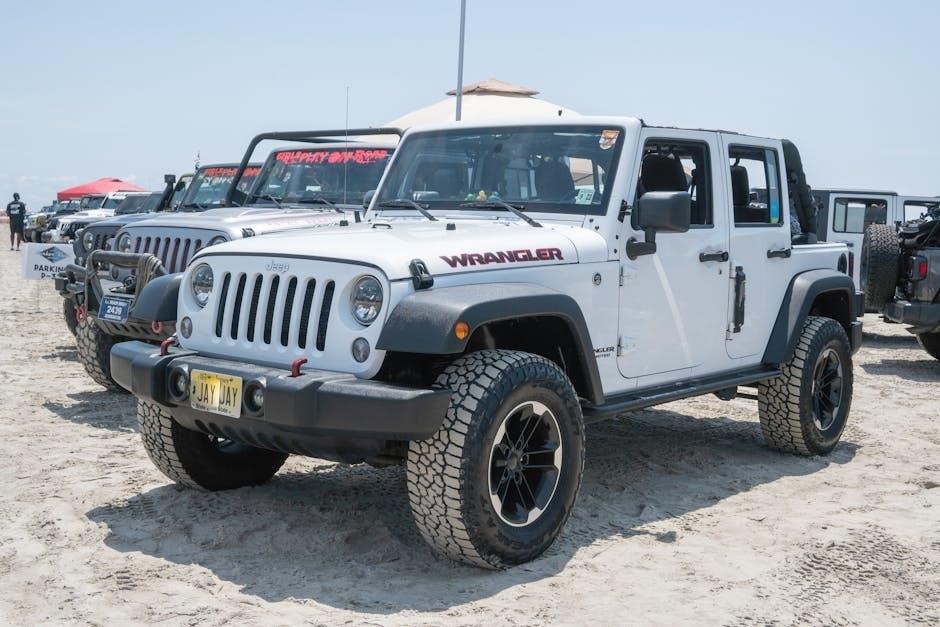
Technical Specifications
The 2015 Jeep Wrangler features a 3․6L V6 engine, producing 285 horsepower and 260 lb-ft of torque․ It offers a 6-speed manual or 5-speed automatic transmission, with a 4WD system․ The axle ratio is 3․21, and the fuel tank capacity is 18․6 gallons․ Maximum towing capacity is 3,500 lbs, with ground clearance of 8․8 inches․
Engine and Transmission Details
The 2015 Jeep Wrangler is equipped with a 3․6L V6 Pentastar engine, delivering 285 horsepower at 6,400 rpm and 260 lb-ft of torque at 4,800 rpm․ This engine features a 24-valve design with dual overhead camshafts, ensuring smooth power delivery and efficiency․ The Wrangler offers two transmission options: a standard 6-speed manual gearbox and an optional 5-speed automatic․ The manual transmission provides precise control, while the automatic offers convenience and ease of use․ Both transmissions are paired with the Command-Trac® 4WD system, enhancing off-road capability․ The engine is water-cooled and utilizes an aluminum alloy block for reduced weight and improved durability․ The recommended fuel type is regular unleaded gasoline, with a fuel tank capacity of 18․6 gallons․ The engine’s compression ratio is 10․2:1, contributing to its robust performance and reliability․
Dimensions and Capacity Specifications
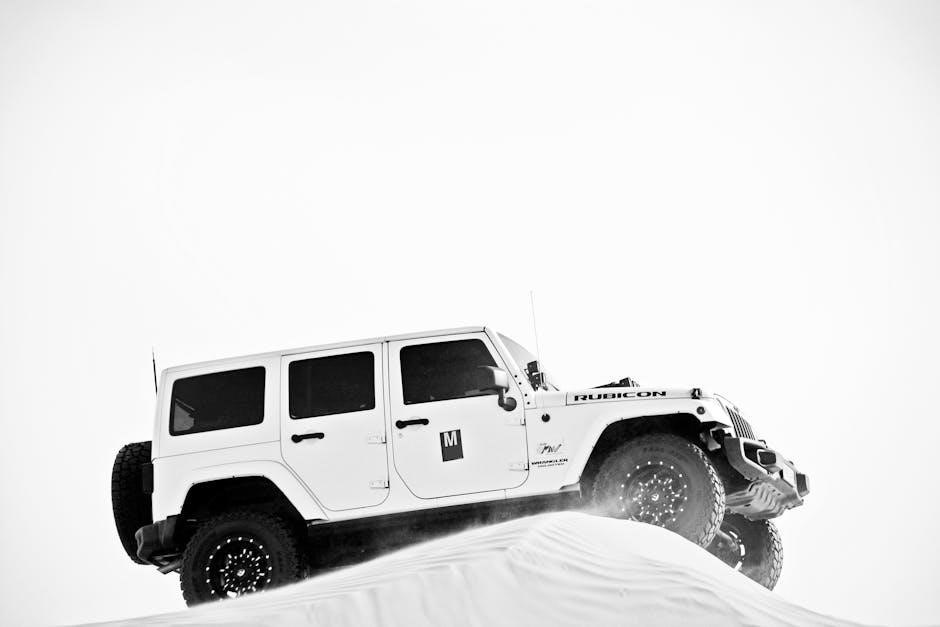
The 2015 Jeep Wrangler measures 173․4 inches in overall length, with a 103․5-inch wheelbase for the 2-door model, and 184․9 inches in overall length with a 116․0-inch wheelbase for the 4-door Unlimited model․ The width is 73․7 inches, and the height is 70․9 inches, providing ample ground clearance for off-road adventures․ The vehicle has a curb weight ranging from 3,651 lbs (manual transmission) to 3,858 lbs (automatic transmission)․ The Wrangler features a maximum payload capacity of 850 lbs and a towing capacity of up to 2,000 lbs․ The fuel tank holds 18․6 gallons, ensuring extended driving range․ The interior offers seating for up to 4 passengers in the 4-door model and 2 passengers in the 2-door model․ Cargo space is limited to 12․8 cubic feet behind the rear seats in the 2-door but expands to 31․5 cubic feet in the 4-door model with the seats folded․
